| Nieuport 10 | |
|---|---|
 | |
| General information | |
| Type | reconnaissance, fighter and trainer |
| Manufacturer | Nieuport |
| Designer | Gustave Delage |
| Status | retired |
| Primary users | Aéronautique Militaire Royal Naval Air Service Imperial Russian Air Service |
| History | |
| Manufactured | 1915-1918 |
| Introduction date | 1915 |
| First flight | 1914 |
| Variants | Nieuport 12 |
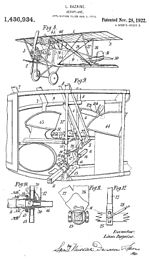

The Nieuport 10 (or Nieuport XB in contemporary sources) is a French First World War sesquiplane that filled a wide variety of roles, including reconnaissance, fighter and trainer.
Design and development
In January 1914, designer Gustave Delage joined the Société Anonyme des Etablissements Nieuport, and started working on a series of aircraft that would remain in production for the remainder of the First World War. The Nieuport 10 was the first of these and was originally designed to compete in the Gordon Bennett Trophy race of 1914. World War I caused this contest to be cancelled, and the type was developed as a military two-seat reconnaissance aircraft that entered service in 1915.
The type featured a distinctive "V" strut layout. The lower wing was much smaller in area than the upper wing. The concept was intended to combine the strength, compactness and stability of the biplane's wire braced wing cell with the speed and ease of handling of the monoplane.
Many were built or converted as single-seat fighters by covering the front cockpit, and adding a Lewis Gun or Vickers machine gun either to fire through the center section of the top wing or mounted over it, firing forwards. In this form, the type was used as a fighter.
Two major types were developed based on experience with the Nieuport 10 - the Nieuport 11 Bébé - a smaller and completely new aircraft, designed from the outset as a single-seater, and the Nieuport 12 - a more powerful two-seater with an enlarged top wing and improved seating for the gunner. In addition, production was undertaken later in the war of a dedicated trainer version under the Nieuport 83 E.2 designation with detail changes. A single example of a triplane, using a Nieuport 10 fuselage was built to test an unusual staggered wing concept.
Operational use
Many of the early French aces flew the Nieuport 10, the best known of which was Georges Guynemer, who used several Nieuport 10s, all marked "Vieux Charles". Jan Olieslagers was flying a Nieuport 10 when he became the first Belgian to shoot down another aircraft, while the first Canadian aerial victory was also scored in a Nieuport 10, by Flight Sub-Lieutenant Arthur Ince.
Variants
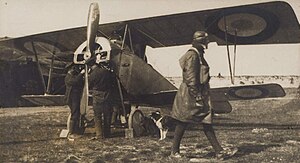 Early French Nieuport X.B reconnaissance aircraft
Early French Nieuport X.B reconnaissance aircraft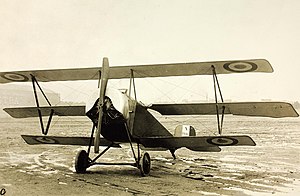 Nieuport 10 triplane
Nieuport 10 triplane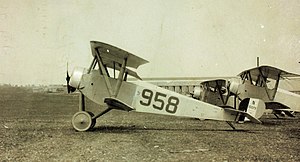 American Nieuport 83 E.2 trainer
American Nieuport 83 E.2 trainer
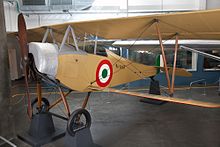
- Nieuport X.B
- Early designation distinguishing it from the earlier unrelated Nieuport X monoplane.
- Nieuport X.AV
- Company designation with the observer/gunner seated in the front and the pilot in the rear.
- Nieuport X.AR
- Company designation with the pilot seated in the front and the observer/gunner in the rear.
- Nieuport 10 A.2
- Two-seat reconnaissance (Artillerie) aircraft, same as Nieuport X.AR.
- Nieuport 10 C.1
- Single-seat fighter variant. Inspired development of Nieuport 11 C.1.
- Nieuport 10 E.2
- Nieuport 10 A.2s used for training.
- Nieuport 83 E.2
- Purpose-built trainer with detail modifications.
- Nieuport 10 triplane
- Testbed for triplane with unusual wing stagger.
- Nieuport-Macchi 10.000
- Italian-built Nieuport 10 with many detail modifications.
- Nieuport 18 or 18 meter Nieuport
- Unofficial description of basic type based on nominal wing area of 18 square meters.
- Nakajima Army Type 甲 2 (Ko 2) Trainer
- Nieuport 83 E.2 built under licence in Japan.
- B.F.2 (training aircraft type 2)
- Siamese designation for imported Nieuport 83 E.2.
Operators
 Belgium
Belgium- Belgian Air Force
 Brazil
Brazil- Brazilian Air Force
 France
France- Aéronautique Militaire
- Aéronavale
 Finland
Finland- Finnish Air Force (ex-Russian examples)
 Finnish Socialist Workers' Republic
Finnish Socialist Workers' Republic- Red Guards (ex-Russian examples)
 Kingdom of Italy
Kingdom of Italy- Corpo Aeronautico Militare
 Japan
Japan- Imperial Japanese Army Air Service
 Portugal
Portugal- Aeronáutica Militar Portuguesa - 7 Nieuport Ni.83E-2 trainers received in 1917.
 Romania
Romania- Romanian Air Corps - one Nieuport 10 purchased in 1915, used as trainer.
 Russian Empire
Russian Empire- Imperial Russian Air Service - imported large numbers and built under licence.
- Imperial Russian Navy - ex Air Service aircraft.
 Serbia
Serbia- Serbian Air Force
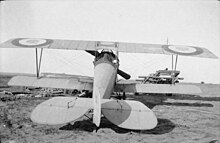
 Ukrainian People's Republic
Ukrainian People's Republic- Ukrainian People's Army (One aircraft only)
 United Kingdom
United Kingdom- Royal Naval Air Service - early user. Note that the Royal Flying Corps did not use the Nieuport 10.
 United States
United States- United States Air Service of the American Expeditionary Force - used as trainers only
 Soviet Union
Soviet Union- Workers' and Peasants' Air Fleet (ex-Russian examples)
Survivors
Two Nieuport-Macchi 10,000's survive and are on display in Italy, one at the Museo Storico Italiano della Guerra and one at the Museo della Scienza e della Tecnologia "Leonardo da Vinci", and an original Nieuport 83 E.2 that had been flown by Charles Nungesser while barnstorming in the United States shortly after the First World War, is at Old Rhinebeck Aerodrome on static display.
Specifications (Nieuport-Macchi 10)
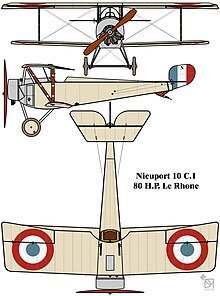
Data from Nieuport Macchi 11 & 17 and French Aircraft of the First World War
General characteristics
- Crew: Two
- Length: 7.01 m (23 ft 0 in)
- Upper wingspan: 8.03 m (26 ft 4 in)
- Upper chord: 1.61 m (5 ft 3 in)
- Wing sweep: 2° 45'
- Lower wingspan: 7.51 m (24 ft 8 in)
- Lower chord: 0.90 m (2 ft 11 in)
- Height: 2.85 m (9 ft 4 in)
- Wing area: 18 m (190 sq ft)
- Empty weight: 440 kg (970 lb)
- Gross weight: 650 kg (1,433 lb)
- Undercarriage track: 1.60 m (5 ft 3 in)
- Powerplant: 1 × le Rhône 9C 9-cylinder air-cooled rotary piston engine, 60 kW (80 hp)
- Propellers: 2-bladed fixed-pitch Régy 155 or Chauviere 2219 propeller, 2.5 m (8 ft 2 in) diameter
Performance
- Maximum speed: 140 km/h (87 mph, 76 kn)
- Range: 300 km (190 mi, 160 nmi)
- Endurance: 2 hours 30 minutes
- Service ceiling: 4,000 m (13,000 ft)
- Time to altitude: 15 minutes 30 seconds to 2,000 m (6,600 ft)
- Wing loading: 36.1 kg/m (7.4 lb/sq ft)
Armament
- Guns: 1 × .303 in (7.70 mm) Lewis machine gun or 7.9 mm (0.31 in) Hotchkiss mounted above the top wing
See also
Related lists
References
Footnotes
- Spooner, 1917, p.884
- ^ Davilla & Soltan, pp. 355–359
- Berner, 1934
- Niccoli 1998, p. 20.
- Dan Antoniu (2014). Illustrated History of Romanian Aeronautics. p. 42. ISBN 978-9730172096.
- Janić, 2011
- Longoni, 1976, p.48
- Davilla, 1997, p358
- ^ Pommier, 2002, p.167
Bibliography
- Apostolo, Giorgio (1991). Aermacchi - from Nieuports to AMX. Milan, Italy: Giorgio Apostolo Editore (GAE).
- Berner, Aarne (1934). "Air Force Participation in Finnish War of Independence in Year 1918. Chapter III. Red Air Activity in Finland y. 1918" (PDF). Retrieved 4 November 2017.
- Bruce, J.M. (1998). Nieuport 10~12 - Windsock Datafile 68. Herts, UK: Albatros Publications. ISBN 978-1902207018.
- Cooksley, Peter (1997). Nieuport Fighters In Action. In Action Aircraft Number 167. Carrollton, TX: Squadron/Signal Publications. ISBN 978-0897473774.
- Davilla, Dr. James J.; Soltan, Arthur (1997). French Aircraft of the First World War. Mountain View, CA: Flying Machines Press. ISBN 978-1891268090.
- Durkota, Alan; Darcey, Thomas; Kulikov, Victor (1995). The Imperial Russian Air Service — Famous Pilots and Aircraft of World War I. Mountain View, CA: Flying Machines Press. ISBN 0-9637110-2-4.
- Janić, Č; Petrović, O (2011). Short History of Aviation in Serbia. Beograd: Aerokomunikacije. ISBN 978-8691397326.
- Longoni, Maurizio (1976). Nieuport Macchi 11 & 17 (in Italian). Milan: Intergest.
- Nicolli, Riccardo (January–February 1998). "Atlantic Sentinels: The Portuguese Air Force Since 1912". Air Enthusiast. No. 73. pp. 20–35. ISSN 0143-5450.
- Pommier, Gerard (2002). Nieuport 1875-1911 — A biography of Edouard Nieuport. Atglen, PA: Schiffer Publishing. ISBN 978-0764316241.
- Rimmell, Ray (1990). World War One Survivors. Bucks: Aston Publications. ISBN 0-946627-44-4.
- Rosenthal, Léonard; Marchand, Alain; Borget, Michel; Bénichou, Michel (1997). Nieuport 1909-1950 Collection Docavia Volume 38. Clichy Cedex, France: Editions Lariviere. ISBN 978-2848900711.
- Sanger, Ray (2002). Nieuport Aircraft of World War One. Wiltshire: Crowood Press. ISBN 978-1861264473.
- Stanley Spooner, ed. (3 Aug 1917). "Some Nieuport "Milestones"". Flight. Vol. IX, no. 35/453. Royal Aero Club. pp. 884–890.
- Taylor, John W. R.; Alexander, Jean (1969). Combat Aircraft of the World. New York: Putnam. pp. 112–113. LCCN 68-25459.
| Nieuport World War One V-strutters | |||||||||||||||||||||
|---|---|---|---|---|---|---|---|---|---|---|---|---|---|---|---|---|---|---|---|---|---|
| Wing area |
| ||||||||||||||||||||
| Foreign production/ designations |
| ||||||||||||||||||||
| Unlicensed copies/derivatives |
| ||||||||||||||||||||
| Related development | |||||||||||||||||||||
| Replicas | |||||||||||||||||||||
| |||||||||||||||||||||
| Nieuport aircraft | |||||||||||||||||||||||||||||||||||||
|---|---|---|---|---|---|---|---|---|---|---|---|---|---|---|---|---|---|---|---|---|---|---|---|---|---|---|---|---|---|---|---|---|---|---|---|---|---|
| Nieuport (1909-1914) | |||||||||||||||||||||||||||||||||||||
| Nieuport (1914-1918) |
| ||||||||||||||||||||||||||||||||||||
| Nieuport-Delage |
| ||||||||||||||||||||||||||||||||||||
| Nieuport (mid 1930s) | |||||||||||||||||||||||||||||||||||||
| Loire-Nieuport | |||||||||||||||||||||||||||||||||||||
| Foreign production |
| ||||||||||||||||||||||||||||||||||||
Wing area used to distinguish different designs by French.
| |||||||||||||||||||||||||||||||||||||
| Nieuport-Macchi/Macchi/Aermacchi aircraft | |
|---|---|
| Nieuport-Macchi | |
| Macchi | |
| Aermacchi | |
| Joint ventures | |
| Purchased designs | |
| Nakajima aircraft | |||||||||||||||||||||
|---|---|---|---|---|---|---|---|---|---|---|---|---|---|---|---|---|---|---|---|---|---|
| Imperial Japanese Navy types |
| ||||||||||||||||||||
| Imperial Japanese Army types |
| ||||||||||||||||||||
| WW2 Allied reporting names | |||||||||||||||||||||
| Royal Thai Armed Forces trainer aircraft designations | |
|---|---|
| B.F (Trainer) | |
| B.KhF (Fighter-trainer) | |